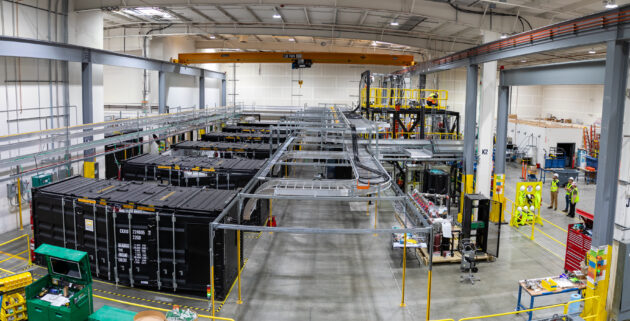Zap Energy confirms $130M round, shares progress on its demo power plant system
Fusion company Zap Energy today shared news on progress with its power plant system demo and gave details on the investors of its $130 million round, which GeekWire first reported in July.
Everett, Wash.-based Zap is part of the daunting race to produce commercially viable energy by smashing together and fusing light atoms, releasing power. It’s the reaction that fuels the sun and other stars, though scientists haven’t be able to efficiently replicate the act on earth.
But they’re getting closer.
Zap launched in 2017 and has focused on its fusion reactor, a device called FuZE-Q, that creates the super high pressure and high temperature conditions for long enough to generate a plasma in which atoms will fuse.
This summer it completed construction of its Century system, which includes a device that produces plasma, as well as other key technologies for making and capturing power, namely liquid metal walls that absorb and transfer the heat produced by fusion, durable electrodes, and energy-releasing capacitors.
Century doesn’t create fusion — that’s still being perfected in FuZE-Q, which was designed to be easier for taking precise performance measurements and making modifications to the device.
Century instead reveals how other crucial components perform so they can be improved while work continues in parallel on the core reactor.
“It’s a really good case study of integrating technology that you’re going to need in a power plant,” said Zap CEO Benj Conway. “Often we talk about science risks. Often we talk about engineering risks. But the risk that a lot is less spoken about are the integration risks.”

The approach has the approval of a slate of investors. The company’s recent Series D round was led by Soros Fund Management with participation by new investors BAM Elevate, Emerson Collective, Leitmotif, Mizuho Financial Group, Plynth Energy and Xplor Ventures.
Current investors participating in the new round include Addition, Breakthrough Energy Ventures, Chevron Technology Ventures, DCVC, Energy Impact Partners, Lowercarbon Capital and Shell Ventures.
Conway called out two of the new investors as particularly noteworthy: Mizuho, which is a large Japanese bank, and Plynth Energy, an Abu Dhabi government-owned early-stage fund.
They are “strategic investors that do not make quick decisions, that spent a lot of time getting to know us to make those investments,” Conway said, adding that they will “be important for us as we scale internationally.”
The company has raised more than $330 million from investors and has 150 employees. It was also selected last year by the U.S. Department of Energy as one of eight recipients of funding from the Milestone-Based Fusion Development Program.
Before scaling becomes an issue, Zap and everyone else in the fusion sector are chasing after “scientific breakeven” — a feat in which they produce more power from fusion than is required to create the reaction.
That was achieved almost two years ago at the Lawrence Livermore National Laboratory’s National Ignition Facility (NIF). It was accomplished with a research-only device of a different design than Zap is pursuing. And the commercial ventures need to go further, creating enough energy to put electrons on the electrical grid.
Zap’s approach to creating fusion uses a sheared-flow-stabilized Z-pinch technology. Its device drives electric currents through a filament of plasma. The current creates powerful magnetic fields around the plasma, compressing the material and producing conditions sufficient for fusion reactions.
Century this summer performed a test run of more than 1,000 consecutive plasmas in less than three hours — a significant achievement, said Conway. However a component in the device didn’t perform as needed so the team is making adjustments and aims to run the test again before the year’s end in order to meet a DOE target.
The fusion field overall has attracted investments from deep pockets in the tech sector, including Chris Sacca’s Lowercarbon Capital, Bill Gate’s Breakthrough Energy Ventures, OpenAI CEO Sam Altman, and Amazon founder Jeff Bezos.
The world’s shift to clean energy has hit recent road bumps as tech’s demand for electricity has ramped up with expanding data center construction and operations. Fusion, if and when someone commercializes it, could become an essential solution for those electricity needs.
“Our aim at Zap isn’t just to prove out a science experiment,” Conway said. “Our objective at Zap is to deliver a commercial power plant.”
RELATED COVERAGE: Fusion startup Zap Energy is raising more cash to develop commercially viable power

